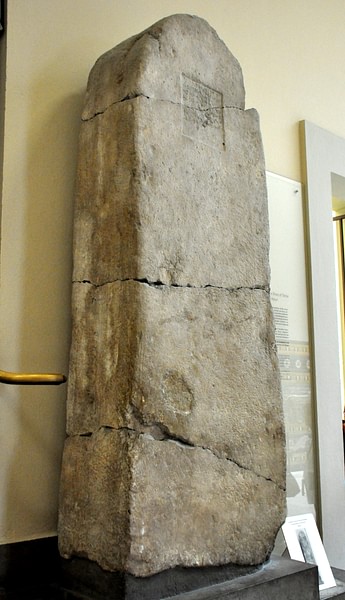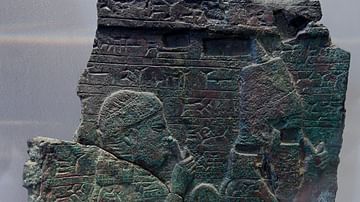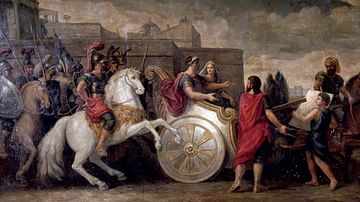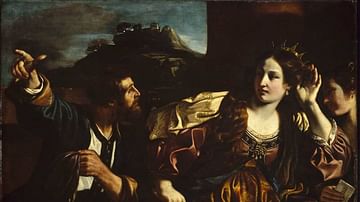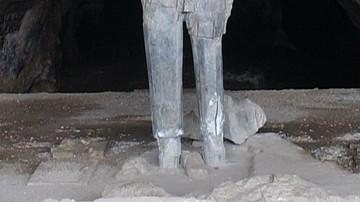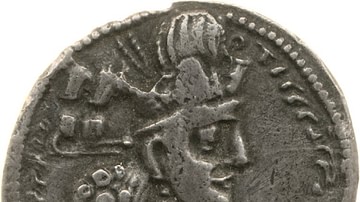The lives of women in ancient Mesopotamia were regulated by a patriarchal hierarchy, but within this social structure, there were many who distinguished themselves and some who were able to assume positions traditionally held by men. Women served as generals, scribes, and even ruled in their own right.
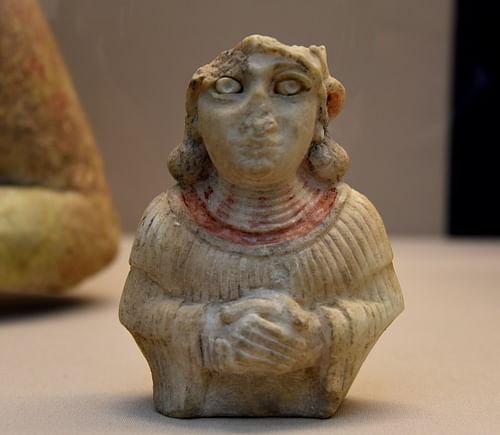
Although women seem to have the greatest measure of equal rights during the Early Dynastic Period of Mesopotamia (2900-2334 BCE), there is evidence of strong women after this period who were able to chart their own destinies within the confines of the patriarchy. Among these were the naditu women of the city of Sippar c. 1880-1550 BCE, who were priestesses dedicated to the male god of the city, Samas (though naditu also ministered to the god Marduk at Babylon and Ninurta at Nippur). These women "engaged in business activities," which were quite lucrative, though their nature is unclear (Leick, 189). They were exempt from the social expectation to bear children, though they could marry, and seem to have lived, more or less, as they pleased.
Queen Esther, from the biblical Book of Esther (4th century BCE), exemplifies the kind of power women could attain even if, as many scholars maintain, she is a fictional character. In the narrative, she is depicted as strong enough to reveal the viceroy Haman's plot to exterminate the Jews of the kingdom to her husband, the Persian king Ahasuerus (associated with Xerxes I, r. 486-465 BCE). Ahasuerus has Haman executed, the Jews are saved, and Esther's uncle is elevated at court. The character of Esther may have been based on earlier Mesopotamian queens who were able to exert the same kind of influence.
Although there are several women throughout the long history of Mesopotamia who are worthy of note, the following ten are among the most impressive:
- Queen Puabi (l. c. 2600 BCE)
- Queen Kubaba (l. c. 2500 BCE)
- Ama-e (c. 2330 BCE)
- Enheduanna (l. 2285-2250 BCE)
- Sammu-Ramat (r. 811-806 BCE)
- Zakutu (l. c. 728 to c. 668 BCE)
- Serua-eterat (l. c. 652 BCE)
- Oracle of Nuska (l. c. 671 BCE)
- Artemisia I of Caria (l. c. 480 BCE)
- Azadokht Shahbanu (wife of Shapur I, r. 240-270 CE)
All of these women, except for Ama-e and the Oracle of Nusku, were royal and are known either from inscriptions relating to Mesopotamian kings, from their own inscriptions or literary works, from records kept by family businesses, from later ancient historians, or in the case of Queen Puabi, from her vast tomb that included artifacts identifying her. Women had significant rights throughout most of Mesopotamia's history, but as scholar Gwendolyn Leick notes:
It seems that female status at high levels diminished progressively after the Early Dynastic Period. There were some remnants of influential positions, such as that of the priestess of the moon god at Ur, which was often held by daughters of the ruling king. Princesses and queens owed their social rank to their relationship with the king and especially some queens could, at times, hold the balance of power after their husband's death. (189)
While this is true, not every queen or daughter of a ruling king was able to take and successfully hold an influential position. Most women, in fact, were never allowed the opportunity to make the kinds of contributions or wield the sort of autonomy as those listed above.
Women's Status in Ancient Mesopotamia
The primary role of women in ancient Mesopotamia was thought to be a wife and mother. Women were expected to marry, bear children, rear them, and take care of the home and their husband's extended family who may have lived with the couple. Women, as with men, were classified according to the social hierarchy, which ran top to bottom:
- king/nobility
- clergy
- upper class
- lower class
- slaves
Within this hierarchy, however, women were further classified as:
- free women of the nobility/upper class
- free women of the clergy
- female administrators
- free Women of the lower class
- prostitutes and/or single women
- dependents belonging to no household (but to a temple)
- female slaves
Upward mobility was possible but by no means probable, and most people died in the same social class and circumstance they were born into. Some of the women on this list were born into nobility, and so, one might think, it is not surprising they should have come to wield the kind of power they did. Mesopotamian upper-class and noble women, however, were still considered of less worth than men, and so the fact that any of them were able to claim and hold supreme authority over males is quite impressive.
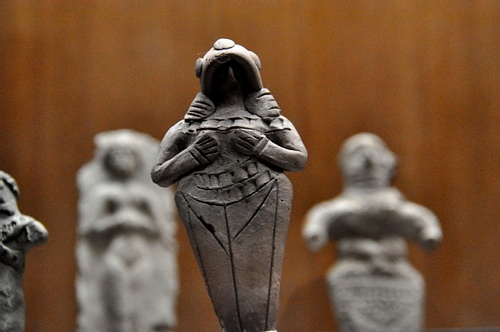
In every case of a female monarch or authority figure, all evidence suggests an effective and prosperous reign, and where the woman is not the central ruling figure, her influence is evident and, according to modern-day scholarship, becoming more evident as in the case of Azadokht Shahbanu. The details of many of these women have been lost (or await discovery), but what is known of their lives suggests powerful individuals who refused to live their lives according to the dictates of others.
Queen Puabi (l. c. 2600 BCE)
Puabi is only known from the 20th-century discovery of her tomb. Queen Puabi's remains were uncovered by the British archaeologist Leonard Wooley at the site he called the Royal Cemetery at Ur in 1922, one of the greatest archaeological finds in history but overshadowed by the discovery of the tomb of Tutankhamun the same year. She is best known for her headdress of golden leaves, ribbons, and strings of carnelian and lapis lazuli beads. Wooley excavated many fascinating and historically valuable artifacts from her tomb and, among them, her cylinder seal – which essentially served as one's personal identification in Mesopotamia – identifying her as a queen without mention of a male consort. Archaeologists and historians have concluded that she most likely ruled in her own right as Queen of Ur in the late Early Dynastic II (2800-2600 BCE) or in the Early Dynastic III (2600-2334 BCE) period. The number of servants and attendants buried with her, along with her vast wealth, attests to a powerful and affluent monarch.
Queen Kubaba (l. c. 2500 BCE)
Kubaba, according to the Sumerian King List (c. 2100 BCE) was a tavern keeper (alewife) before becoming Queen of Kish. There is no record on how she was able to elevate herself, but she is the only woman to appear on the King List as a reigning monarch.
"The Third Dynasty of Kish was said to have been founded by a woman, the 'innkeeper' Kubaba…who was defeated by the ruler of Akshak. Her son, Puzur-Sin, regained power and initiated the Fourth Dynasty of Kish." (Leick, 99-100)
She is therefore associated with both the 3rd and 4th dynasties of Kish. According to some scholars, she was the inspiration, in part, for the later Anatolian goddess Cybele. The dynasty she established ended, as did the Early Dynastic Period, with the rise of Sargon of Akkad (the Great, r. 2334-2279 BCE) who founded the Akkadian Empire.
Ama-e (c. 2330 BCE)
Ama-e was a successful Sumerian businesswoman of the city of Umma who, though married, ran her own business under her own name. Scholar H. J. Marsman writes:
In early Mesopotamian society, women appear to have acted quite independently [and] could stand surety for someone else [as with] the businesswoman Ama-e, who lived in Sargonic Umma. She engaged in trade involving grain, wool, and metals (401).
She used some of the profits to invest in real estate and building projects and oversaw a widespread trade network. These details were preserved in the records of the family business, but nothing of her life is known except that she was married to a man named Ur-Sara.
Enheduanna (l. 2285-2250 BCE)
Enheduanna was the daughter of Sargon of Akkad, though there is some question as to whether she was his natural daughter or whether 'daughter' was an honorary title. She is the first author in the world known by name and became famous in her lifetime as High Priestess of Ur to the moon god Nanna and for her works in praise of the goddess Inanna, which provided a more intimate image of one's relationship to the divine than earlier hymns by male scribes. She also wrote personal poetry, survived a coup in the city that forced her into exile, and then returned to continue as priestess and poet for over 40 years. Her works influenced the writing of later psalms and are still used as models for liturgical and personal poetry in the present day.
Sammu-Ramat (r. 811-806 BCE)
Sammu-Ramat (also given as Sammuramat) was queen regent for her young son Adad Nirari III (r. 811-783 BCE) of the Assyrian Empire after the death of her husband Shamshi-Adad V (r. 823-811 BCE). Women were prohibited from positions of authority over men, and there had never been an Assyrian queen before her. She initiated building projects, commissioned her own obelisk inscribed with her name, and may have led military campaigns to secure the empire and maintain stability. Her reign is thought to have inspired the later tales of the legendary queen Semiramis, who was raised by doves, conquered Mesopotamia, took a series of handsome lovers, and, upon her death, turned into a dove and flew away. The details of Sammu-Ramat's actual reign are unclear (some scholars claim she never even existed), but her ability to govern in her own right, and simply commission an obelisk with her own inscription, attest to a powerful woman who directed her own destiny.
Zakutu (l. c. 728 to c. 668 BCE)
Zakutu is another such woman who rose from the obscurity of a secondary wife to Queen Dowager, Mother of the King, and grandmother of a king. She was a 'palace woman', a secondary wife of Sennacherib (r. 705-681 BCE), who somehow managed to have her son Esarhaddon (r. 681-669 BCE) named as his successor even though he was the youngest of at least eleven sons, many of them born of Sennacherib's queen, Tashmetu-sharrat (d. c. 684/681 BCE). During Esarhaddon's reign, she commissioned his palace at Nineveh and issued her own dedicatory inscription, and, in either 670 or 668 BCE, issued her famous Treaty of Zakutu, ensuring a smooth transition of power for her grandson Ashurbanipal (r. 668-627 BCE), who then took the throne after his father's death. She remained a formidable presence at court early in her grandson's reign before either retiring from public life or dying.
Serua-eterat (l. c. 652 BCE)
Another powerful woman in the same family was Serua-eterat, the eldest daughter of Esarhaddon and older sister to Ashurbanipal. She is the only one of Esarhaddon's daughters known by name as she appears in lists concerning festivals along with her brothers. Despite being a woman, and therefore regarded as of less worth than a male, she is listed third after Ashurbanipal (heir apparent) and his younger brother who was to rule Babylon but above her other brothers, suggesting she held high rank at court. Like her grandmother, she seems to have wielded considerable power and is best known for a letter chastising her sister-in-law (wife of Ashurbanipal) for laziness in study and risking bringing shame on the family by being uneducated.
Oracle of Nuska (l. c. 671 BCE)
The Oracle of Nuska was an unnamed slave girl who became embroiled in a plot to overthrow Esarhaddon c. 671 BCE. Unlike any official oracle, the girl was not attached to a sacred site or temple but was the property of a man named Bel-ahu-usur. At some point c. 671 BCE, she began acting as though possessed by divine spirits and gave the prophecy that Esarhaddon would soon fall and an official named Sasi would become king of the Assyrian Empire. Sasi took her prophecy seriously and brought her into his home as he began to plot a coup, but Esarhaddon, who had a lifelong interest in astrology and prophecy, also took the oracle seriously and took measures to protect himself, including trying to capture the girl at the center of the plot. In 670 BCE, he succeeded, and while her fate is unknown, she was probably executed along with Sasi and the other conspirators. Her significance rests on her unorthodox position as a slave girl who was not attached to a site or temple, suggesting the kind of powerful and charismatic personality that made people listen to her and elevated her from slave to honored guest in Sasi's home and instigator of a plot to topple a powerful Assyrian king.
Artemisia I of Caria (l. c. 480 BCE)
Artemisia I was Queen of Caria (in modern-day Turkey) and is best known for her part in the Battle of Salamis in 480 BCE during Xerxes I's invasion of Greece. She was queen regent for her young son after the death of her husband but ruled according to her own judgment without male supervision or counsel. She is immortalized by Herodotus in his praise of her at Salamis:
I pass over all the other officers because there is no need for me to mention them, except Artemisia…hers was the second most famous squadron in the entire navy. (VII.99).
She is not only known for her comportment at Salamis but also for the advice she gave Xerxes I prior to the battle, suggesting they starve the Greeks into submission rather than engaging them in battle. Xerxes I ignored her suggestion, was defeated at Salamis, and his invasion then failed. Artemisia I escorted Xerxes I's sons back to Persia and then disappears from the historical record.
Azadokht Shahbanu (wife of Shapur I, r. 240-270 CE)
Azadokht Shahbanu has long been known as a diplomat for the Sassanian Empire under Shapur I, his primary consort and wife, and a skilled swordswoman, but modern scholarship is increasingly leaning toward identifying her as a guiding force in Shapur I's reign and the one responsible for establishing the great intellectual, cultural, and medical center of Gundeshapur. Her name, Azadokht, means "free girl" while, Shahbanu is a title ("wife of the king"). One of the high points of Shapur I's impressive reign has always been recognized as the establishment of the Gundeshapur teaching hospital and library, but recent scholarship points to Azadokht as the one who invited Greek physicians to Shapur I's court for the purpose of founding the hospital and teaching center. She is known for her ability with weaponry and may also have owned her own business, though this claim is challenged.
Conclusion
As Leick, and other scholars, have noted, women's rights in ancient Mesopotamia declined after the Early Dynastic Period, and various theories have been suggested as to the cause. Among them is the correlation of the rise of male deities which replaced the many goddesses of the Sumerians of the earlier period. This theory, advanced by the scholar Samuel Noah Kramer, among others, is challenged, but when the monotheistic religion of Islam became dominant after the fall of the Sassanian Empire in 651 CE, there is a clear decline in women's status. Still, as scholar Jean Bottero notes:
In Mesopotamia, as elsewhere, every woman had up her sleeve two reliable trump cards to stand up to any representative of the so-called "strong" sex, and even to dominate him, in spite of all the customary or legal constraints: first, her femininity; then, her personality, spirit, and character. And it was up to her to make use of these to swim against the opposing current of the contemporary mindset. (118-119)
Even after 651 CE, there were women who found a way to express themselves and live according to their own vision. In the case of these ten famous women, their personality, spirit, and character seem to have played the most important role in winning them a place in the historical record, and the same could be said for the others not mentioned here. There were, no doubt, many additional women of equally impressive talents and skills, however, whose names have been lost simply because they never found the opportunity to share them.

